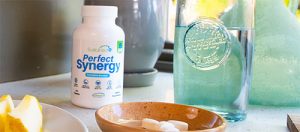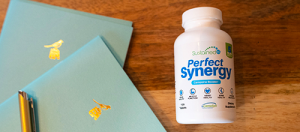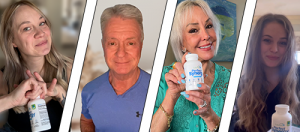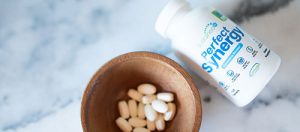Carnosine
The Scientific Mechanism Behind Perfect Synergy®
Carnosine
The Scientific Mechanism Behind Perfect Synergy®
Thousands Of Scientific Studies On Carnosine
One Of The Most Studied Naturally Occurring Compounds
Thousands Of Scientific Studies On Carnosine
One Of The Most Studied
Naturally Occurring Compounds
# of Studies on Carnosine
by General Scientific Discipline
# of Studies on Carnosine
by General Scientific Discipline

# of Studies on Carnosine
by Applied Scientific Discipline
# of Studies on Carnosine
by Applied Scientific Discipline

Derave, W., De Courten, B. & Baba, S.P.
An update on carnosine and anserine research.
Amino Acids 51, 1–4 (2019).
Derave, W., De Courten, B. & Baba, S.P.
An update on carnosine and anserine research.
Amino Acids 51, 1–4 (2019).
How Carnosine Works
Carnosine Is A Natural Anti-Aging Compound In Your Body
SR CarnoSyn® is clinically proven to increase carnosine levels
How Carnosine Works
Carnosine Is A Natural Anti-Aging Compound In Your Body
SR CarnoSyn® is clinically proven to increase carnosine levels
Studies show that Carnosine works to counteract harmful aging processes:
- Physical and muscle function decline, the decrease of muscle and bone capacity and integrity is counteracted by Carnosine. Carnosine helps to maintain and extend the function of cellular organisms and enzymes to improve physical activity capacity, fatigue threshold, and muscle functionality. 1-5
- Oxidation, the reaction between free radicals and compounds in your body from cellular to systemic level, is counteracted by Carnosine. Carnosine scavenges free radicals and their derivatives to stop destructive chain reactions and damage to fat and DNA molecules. 6-10
- Accumulation of excess metals, which occurs over time due to biochemical imbalance and dysfunction, is counteracted by Carnosine. Carnosine binds to the transition metal ions known to induce production of amyloid beta and other proteins that may lead to the development of neurodegenerative issues. 11-12
- Mitochondrial dysfunction, which is the reduced efficiency of mitochondria leading to a reduced cellular energy supply and increased cellular imbalance, is counteracted by Carnosine. Carnosine alleviates and defends against aging induced oxidative stress on mitochondria by its various detoxification pathways, especially in vulnerable brain cells where mitochondrial dysfunction can lead to neurodegenerative processes. 13-15
- Glycation of proteins, which is the undesirable and damaging modification of proteins by exposure to reducing sugars, is counteracted by Carnosine. Carnosine reduces glycation by sacrificing itself to protect other vulnerable proteins and vital biomolecules, such as enzymes and organ structure tissues. 16-19
- Protein cross-linking, which occurs by oxidation or glycation and damages cells and tissues, is counteracted by Carnosine. Carnosine reacts with these abnormal proteins to assist in their elimination preventing further damage to cells and tissues. 20-21
[rev_slider alias=”slider-1-1″][/rev_slider]

Studies show that Carnosine works to counteract harmful aging processes:
- Physical and muscle function decline, the decrease of muscle and bone capacity and integrity is counteracted by Carnosine. Carnosine helps to maintain and extend the function of cellular organisms and enzymes to improve physical activity capacity, fatigue threshold, and muscle functionality. 1-5
- Oxidation, the reaction between free radicals and compounds in your body from cellular to systemic level, is counteracted by Carnosine. Carnosine scavenges free radicals and their derivatives to stop destructive chain reactions and damage to fat and DNA molecules. 6-10
- Accumulation of excess metals, which occurs over time due to biochemical imbalance and dysfunction, is counteracted by Carnosine. Carnosine binds to the transition metal ions known to induce production of amyloid beta and other proteins that may lead to the development of neurodegenerative issues. 11-12
- Mitochondrial dysfunction, which is the reduced efficiency of mitochondria leading to a reduced cellular energy supply and increased cellular imbalance, is counteracted by Carnosine. Carnosine alleviates and defends against aging induced oxidative stress on mitochondria by its various detoxification pathways, especially in vulnerable brain cells where mitochondrial dysfunction can lead to neurodegenerative processes. 13-15
- Glycation of proteins, which is the undesirable and damaging modification of proteins by exposure to reducing sugars, is counteracted by Carnosine. Carnosine reduces glycation by sacrificing itself to protect other vulnerable proteins and vital biomolecules, such as enzymes and organ structure tissues. 16-19
- Protein cross-linking, which occurs by oxidation or glycation and damages cells and tissues, is counteracted by Carnosine. Carnosine reacts with these abnormal proteins to assist in their elimination preventing further damage to cells and tissues. 20-21
References:
References:
- Furst T, Massaro A, Miller C, Williams BT, LaMacchia ZM, Horvath PJ. β-Alanine supplementation increased physical performance and improved executive function following endurance exercise in middle aged individuals. J Int Soc Sports Nutr. 2018;15(1):32. Published 2018 Jul 11. doi:10.1186/s12970-018-0238-7
- McCormack WP, Stout JR, Emerson NS, et al. Oral nutritional supplement fortified with beta-alanine improves physical working capacity in older adults: a randomized, placebo-controlled study. Exp Gerontol. 2013;48(9):933‐939. doi:10.1016/j.exger.2013.06.003
- Glenn JM, Gray M, Stewart R, et al. Incremental effects of 28 days of beta-alanine supplementation on high-intensity cycling performance and blood lactate in masters female cyclists. Amino Acids. 2015;47(12):2593‐2600. doi:10.1007/s00726-015-2050-x
- Stout JR, Graves BS, Smith AE, et al. The effect of beta-alanine supplementation on neuromuscular fatigue in elderly (55-92 Years): a double-blind randomized study. J Int Soc Sports Nutr. 2008;5:21. Published 2008 Nov 7. doi:10.1186/1550-2783-5-21
- del Favero S, Roschel H, Solis MY, et al. Beta-alanine (Carnosyn™) supplementation in elderly subjects (60-80 years): effects on muscle carnosine content and physical capacity. Amino Acids. 2012;43(1):49‐56. doi:10.1007/s00726-011-1190-x
- Hipkiss AR. Carnosine, a protective, anti-ageing peptide? Int J Biochem Cell Biol. 1998 Aug;30(8):863-8
- Hyland P, Duggan O, Hipkiss A, Barnett C, Barnett Y. The effects of carnosine on oxidative DNA damage levels and in vitro life span in human peripheral blood derived CD4+T cell clones. Mech Ageing Dev. 2000 Dec 20;121(1-3):203-15
- Hipkiss AR, Preston JE, Himsworth DT, et al. Pluripotent protective effects of carnosine, a naturally occurring dipeptide. Ann N Y Acad Sci. 1998 Nov 20;854:37-53
- Reddy VP, Garrett MR, Perry G, Smith MA. Carnosine: a versatile antioxidant and antiglycating agent. Sci Aging Knowledge Environ. 2005 May 4;2005(18):pe12
- Carvalho VH et al. “Exercise and β-alanine supplementation on carnosine-acrolein adduct in skeletal muscle.” Redox Biol. 2018 Sep;18:222-228
- Hipkiss AR. Could carnosine or related structures suppress Alzheimer’s disease? J Alzheimers Dis. 2007 May;11(2):229-40
- Boldyrev AA, Stvolinsky SL, Fedorova TN, Suslina ZA. Carnosine as a natural antioxidant and geroprotector: from molecular mechanisms to clinical trials. Rejuvenation Res. 2010 Apr-Jun;13(2-3):156-8
- Corona C, Frazzini V, Silvestri E, et al. Effects of dietary supplementation of carnosine on mitochondrial dysfunction, amyloid pathology, and cognitive deficits in 3xTg-AD mice. PLoS One. 2011;6(3):e17971
- Cheng J, Wang F, Yu DF, Wu PF, Chen JG. The cytotoxic mechanism of malondialdehyde and protective effect of carnosine via protein cross-linking/mitochondrial dysfunction/reactive oxygen species/MAPK pathway in neurons. Eur J Pharmacol. 2011 Jan 10;650(1):184-94
- Hipkiss AR. Aging, proteotoxicity, mitochondria, Glycation, NAD and Carnosine: Possible Inter-relationships and resolution of the oxygen paradox. Front Aging Neurosci. 2010;2:10
- Bellia F, Vecchio G, Cuzzocrea S, Calabrese V, Rizzarelli E. Neuroprotective features of carnosine in oxidative driven diseases. Mol Aspects Med. 2011 Aug;32(4-6):258-66
- Reddy VP, Garrett MR, Perry G, Smith MA. Carnosine: a versatile antioxidant and antiglycating agent. Sci Aging Knowledge Environ. 2005 May 4;2005(18):pe12
- Hipkiss AR, Michaelis J, Syrris P. Non-enzymatic glycosylation of the dipeptide L-carnosine, a potential anti-protein-cross-linking agent. FEBS Lett. 1995 Aug 28;371(1):81-5
- McFarland GA, Holliday R. Retardation of the senescence of cultured human diploid fibroblasts by carnosine. Exp Cell Res. 1994;212(2):167‐175. doi:10.1006/excr.1994.1132
- Hipkiss AR, Brownson C, Bertani MF, Ruiz E, Ferro A. Reaction of carnosine with aged proteins: another protective process? Ann N Y Acad Sci. 2002 Apr;959:285-94
- Hipkiss AR. On the enigma of carnosine’s anti-ageing actions. Exp Gerontol. 2009 Apr;44(4):237-42
- Furst T, Massaro A, Miller C, Williams BT, LaMacchia ZM, Horvath PJ. β-Alanine supplementation increased physical performance and improved executive function following endurance exercise in middle aged individuals. J Int Soc Sports Nutr. 2018;15(1):32. Published 2018 Jul 11. doi:10.1186/s12970-018-0238-7
- McCormack WP, Stout JR, Emerson NS, et al. Oral nutritional supplement fortified with beta-alanine improves physical working capacity in older adults: a randomized, placebo-controlled study. Exp Gerontol. 2013;48(9):933‐939. doi:10.1016/j.exger.2013.06.003
- Glenn JM, Gray M, Stewart R, et al. Incremental effects of 28 days of beta-alanine supplementation on high-intensity cycling performance and blood lactate in masters female cyclists. Amino Acids. 2015;47(12):2593‐2600. doi:10.1007/s00726-015-2050-x
- Stout JR, Graves BS, Smith AE, et al. The effect of beta-alanine supplementation on neuromuscular fatigue in elderly (55-92 Years): a double-blind randomized study. J Int Soc Sports Nutr. 2008;5:21. Published 2008 Nov 7. doi:10.1186/1550-2783-5-21
- del Favero S, Roschel H, Solis MY, et al. Beta-alanine (Carnosyn™) supplementation in elderly subjects (60-80 years): effects on muscle carnosine content and physical capacity. Amino Acids. 2012;43(1):49‐56. doi:10.1007/s00726-011-1190-x
- Hipkiss AR. Carnosine, a protective, anti-ageing peptide? Int J Biochem Cell Biol. 1998 Aug;30(8):863-8
- Hyland P, Duggan O, Hipkiss A, Barnett C, Barnett Y. The effects of carnosine on oxidative DNA damage levels and in vitro life span in human peripheral blood derived CD4+T cell clones. Mech Ageing Dev. 2000 Dec 20;121(1-3):203-15
- Hipkiss AR, Preston JE, Himsworth DT, et al. Pluripotent protective effects of carnosine, a naturally occurring dipeptide. Ann N Y Acad Sci. 1998 Nov 20;854:37-53
- Reddy VP, Garrett MR, Perry G, Smith MA. Carnosine: a versatile antioxidant and antiglycating agent. Sci Aging Knowledge Environ. 2005 May 4;2005(18):pe12
- Carvalho VH et al. “Exercise and β-alanine supplementation on carnosine-acrolein adduct in skeletal muscle.” Redox Biol. 2018 Sep;18:222-228
- Hipkiss AR. Could carnosine or related structures suppress Alzheimer’s disease? J Alzheimers Dis. 2007 May;11(2):229-40
- Boldyrev AA, Stvolinsky SL, Fedorova TN, Suslina ZA. Carnosine as a natural antioxidant and geroprotector: from molecular mechanisms to clinical trials. Rejuvenation Res. 2010 Apr-Jun;13(2-3):156-8
- Corona C, Frazzini V, Silvestri E, et al. Effects of dietary supplementation of carnosine on mitochondrial dysfunction, amyloid pathology, and cognitive deficits in 3xTg-AD mice. PLoS One. 2011;6(3):e17971
- Cheng J, Wang F, Yu DF, Wu PF, Chen JG. The cytotoxic mechanism of malondialdehyde and protective effect of carnosine via protein cross-linking/mitochondrial dysfunction/reactive oxygen species/MAPK pathway in neurons. Eur J Pharmacol. 2011 Jan 10;650(1):184-94
- Hipkiss AR. Aging, proteotoxicity, mitochondria, Glycation, NAD and Carnosine: Possible Inter-relationships and resolution of the oxygen paradox. Front Aging Neurosci. 2010;2:10
- Bellia F, Vecchio G, Cuzzocrea S, Calabrese V, Rizzarelli E. Neuroprotective features of carnosine in oxidative driven diseases. Mol Aspects Med. 2011 Aug;32(4-6):258-66
- Reddy VP, Garrett MR, Perry G, Smith MA. Carnosine: a versatile antioxidant and antiglycating agent. Sci Aging Knowledge Environ. 2005 May 4;2005(18):pe12
- Hipkiss AR, Michaelis J, Syrris P. Non-enzymatic glycosylation of the dipeptide L-carnosine, a potential anti-protein-cross-linking agent. FEBS Lett. 1995 Aug 28;371(1):81-5
- McFarland GA, Holliday R. Retardation of the senescence of cultured human diploid fibroblasts by carnosine. Exp Cell Res. 1994;212(2):167‐175. doi:10.1006/excr.1994.1132
- Hipkiss AR, Brownson C, Bertani MF, Ruiz E, Ferro A. Reaction of carnosine with aged proteins: another protective process? Ann N Y Acad Sci. 2002 Apr;959:285-94
- Hipkiss AR. On the enigma of carnosine’s anti-ageing actions. Exp Gerontol. 2009 Apr;44(4):237-42
Support
Keep in touch.
1-800-848-2636











